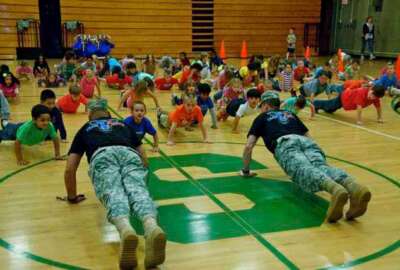
Military group calls for better child nutrition to increase military readiness
A new report frets over the growing obesity epidemic and its impact on the military.
A group of retired military leaders is calling on states and the federal government to provide good nutrition settings for children in order to slash the obesity rate and make more people eligible for military service in the future.
The Mission: Readiness, part of the Council for a Strong America, released a new report that advocates for legislation requiring and subsidizing nutritious foods in day cares and schools. It also calls for schools and day care centers to require more physical activity for children.
“One program in Wisconsin has to do with encouraging active early activity as opposed to the thumb game on your gadget day in and day out for 12 hours a day, what a refreshing thing it might be to see the sun and do a little running around and play a little ball,” said James Loy, former commandant of the Coast Guard.
The report supports the Child Nutrition Reauthorization Act, which improves guidelines for food and drinks available in schools.
“Since the new standards were implemented, fruit and vegetable consumption by participating children increased by 16 and 23 percent, respectively,” the report stated. “Over 90 percent of schools now serve meals that meet the healthier standards.”
The report comes as the number of 17- to 24-year-olds ineligible for military service due to obesity ballooned to 31 percent.
That’s taking a toll on the military, especially considering 71 percent of people in that age range cannot serve in the military due to health issues, criminal records, drug use or lack of education.
“We know that the military cannot solve this problem on its own,” said Thomas Spoehr, a retired Army lieutenant general. “Children as young as two are experiencing rising obesity rates, and these rates increase with age. This demonstrates the need for obesity prevention beginning very early in life and continuing through high school and beyond.”
In 2018, the Army missed its recruitment goals for the first time in more than a decade. It fell short by 6,500 soldiers and only recruited 70,000.
To meet its goal in 2019, the Army is changing its tactics by designing a new television commercial and working in new online platforms to reach younger audiences.
The Army will step up its efforts in 22 cities across the nation, including areas not known for joining the military like San Francisco, Boston and Seattle.
“We are going to target these 22 cities to surge into those cities with a focused recruiting campaign throughout the year,” Gen. Stephen Townsend, Army Training and Doctrine Command leader, said last week.
Another issue is that some troops who are obese in the military are at higher risk for injury.
“Active duty soldiers with obesity were 33 percent more likely to suffer musculoskeletal injury, contributing to the more than 3.6 million injuries that occurred among active duty service members between 2008 and 2017,” the report stated.
In 2015, 7.8 percent of active duty service members were considered overweight. That is a 73 percent increase from 2011.
Read more of the DoD Personnel Notebook.
Copyright © 2025 Federal News Network. All rights reserved. This website is not intended for users located within the European Economic Area.
Scott Maucione is a defense reporter for Federal News Network and reports on human capital, workforce and the Defense Department at-large.
Follow @smaucioneWFED




